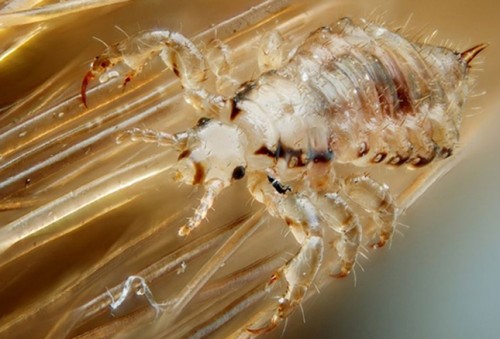Children’s Back To School Medical Problems – Part 1
Ask any medical student, intern or resident: “where is the place where you get sick most often” and you’ll be told “the hospital.”
The problem is that the relationship also holds for “adults” with “work” and “children” with “school.” That’s because those locations are where “all the already-sick people are!” And we get it from them.
Back to School Medical Problems
Let’s take this opportunity at “back to school” time to discuss the frequently incurred illnesses and problems we all face as our kids leave their “high mountain spaces” and go back to those “hallowed” but confined halls of knowledge and breeding grounds for organisms that get them sick. You know, “Praemonitus, praemunitus” – “forewarned is forearmed.”
I ran across an interesting article in an online journal (Medscape) that I wanted to give you the link to. Unfortunately, they consider it for doctors only, and make you to register to get in; SO, I’ve decided to write my own version of the topic in a way that you can have some fun trying to test your knowledge. The photos come from Wikipedia Commons so I can re-post them for you to see.
Head and Hair Itching
Head Lice (Pediculosis Capitis) used to be one of the most ubiquitous of all childhood maladies – it’s less so now, but it is making a come back lately. It’s itchy and most often spread by direct contact with the hair of an infected person during play or other contact. [photo above]
It’s less commonly spread through hats, scarves, coats or other clothing items or combs, brushes or towels; but, it can be a bear to resolve on your own. Hair cutting, multiple linen washings, medications and treating all “intimate contact” household members are all methods used.
Crusty Splotches on Scalp
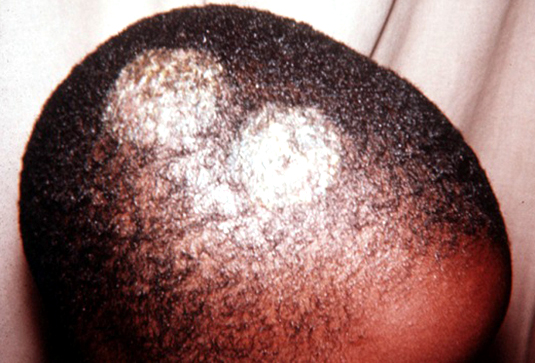 This student developed a rash on his scalp which grew in size over several weeks after starting school. As you can see there is a lot of scaling but no inflammation and his hair has taken on a dull, grayish, discolored appearance and begun breaking off.
This student developed a rash on his scalp which grew in size over several weeks after starting school. As you can see there is a lot of scaling but no inflammation and his hair has taken on a dull, grayish, discolored appearance and begun breaking off.
If you look really close you can see tiny papules around the hair shafts and the lesion eventually forms a ring. Have you seen this before?
Ringworm. Also known as Tinea Capitis, a very itchy fungal infection which most often affects children but can occur at any age.
It is contagious, spreads very easily to others and this is the one which you can get from combs, hats, clothing or touching an infected spot on the body of another person. It can ALSO be spread by pets (especially cats) and is treated (with great difficulty) using shampoos and oral medication, although it often returns. Fortunately, it often resolves at puberty.
Vesicles Around Mouth, Hands and Feet
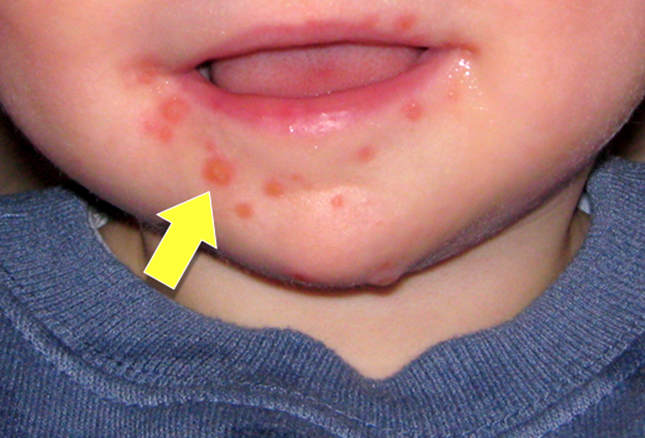 This pre-schooler was well until his third week in a new school and he developed all these blisters around his mouth. They seem to be elliptical and are aligned with their long axis oriented along the skin lines with a red halo around their base. This has got to be a virus – do you know which one?
This pre-schooler was well until his third week in a new school and he developed all these blisters around his mouth. They seem to be elliptical and are aligned with their long axis oriented along the skin lines with a red halo around their base. This has got to be a virus – do you know which one?
Hand, foot, and mouth disease (HFMD) is contracted basically from slobber – saliva, sputum, nasal mucus, fluid in blisters or even stools from the infected person.
The blisters come on the hands, feet and around the mouth and attacks, “under-fives” more than adults, with a skin rash, blisters and fever. The virus is an Enterovirus, mostly likely Coxsackievirus A type 16 (in case you’re ever asked.)
Sore Throat and a Rash
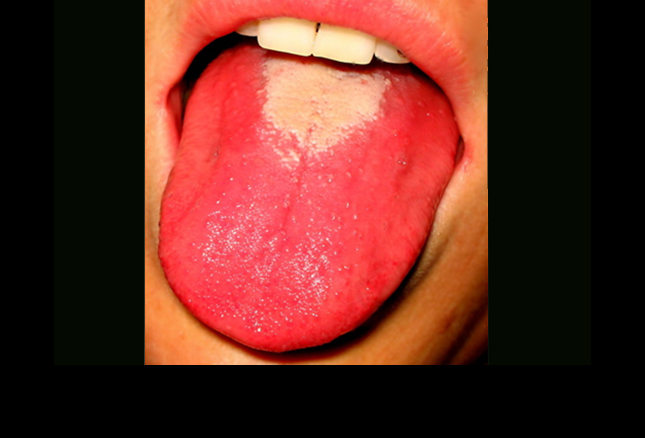 This illness comes under the heading of “I thought they got rid of that.” Nope! It’s still around.
This illness comes under the heading of “I thought they got rid of that.” Nope! It’s still around.
This boy developed a fever and sore throat for a couple of days and was initially sent back to school because the symptoms weren’t all that bad. His throat seemed to get more sore and looked really red.
It was difficult to swallow and his fever continued so he was taken to the doctor who noticed a rash on his neck and chest. The question is: what did the throat culture that the doctor took, show?
 Answer: this boy has Scarlet Fever so the culture will show group A beta-hemolytic Streptococci. Group A Strep not only causes a sore throat at the infected site but it also excretes an erythrogenic exotoxin into the tissues and blood which does “naughty” things to other organs.
Answer: this boy has Scarlet Fever so the culture will show group A beta-hemolytic Streptococci. Group A Strep not only causes a sore throat at the infected site but it also excretes an erythrogenic exotoxin into the tissues and blood which does “naughty” things to other organs.
The tongue can (but doesn’t have to) take on a “strawberry” appearance and the toxin causes the skin to rash up with a particular texture – sandpaper. This disease is also one of the very few which gives a rash on the hands and they eventually begin to peel. A sore throat with a sandpaper rash is almost pathognomonic of Scarlet Fever.
Rash lasts for a week and it causes the skin to peel as it eventually heels. If the strep toxin makes it to another organ in the body you get another disease called by a different name – but that’s another question.
A Red Draining Eye
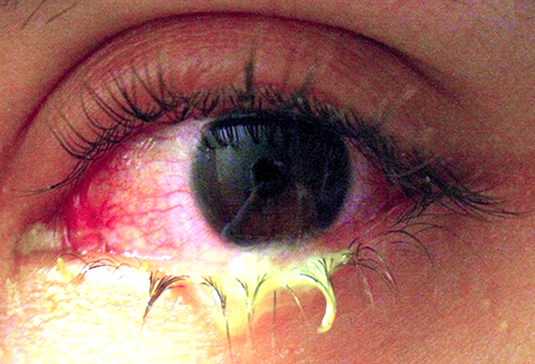 This boy started his wrestling season and came down with an itchy red eye after his first match – Bacterial Conjunctivitis.
This boy started his wrestling season and came down with an itchy red eye after his first match – Bacterial Conjunctivitis.
The disease is really, really common in children and presents with a red, itchy eye. Some times there is little drainage but in others there is a lot of matter, especially in the morning after sleep. It may even be crusted completely shut producing a frightened scream for “mommy, I can’t see!”
Often it becomes an epidemic of sorts, going through the school as one child rubs his eye after touching something another has put his hand on – or wrestling. And, runs through family households like wildfire.
The eye is red, itches and drains, and is often caused by the bacteria H. Influenzae (not the flu) or S. Pneumoniae (not pneumonia).
Most cases are self-limited, although antimicrobial treatment reduces complications and expedites resolution. It can be associated with concurrent upper respiratory tract infections and otitis media and is usually treated with topical antibiotics.
Dew Drops On A Rose Petal Rash
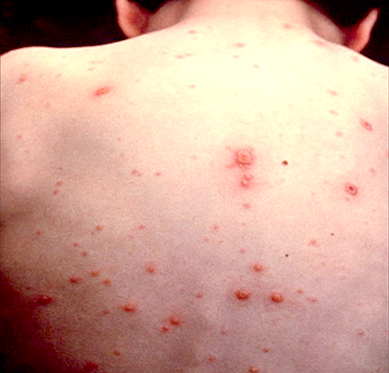 You know, this rash probably would be chapter one of the book: “rashes for dummies.”
You know, this rash probably would be chapter one of the book: “rashes for dummies.”
However, these days if you miss this one it probably shows that you’re not so much a new parent as just a very young one. You’ve never had the disease, and mostly likely neither has your mother – if you live in the US.
BUT, if you send this boy to school you’ll be summoned back before you get out of the parking lot and find him in the nurses office with a note pinned to his shirt saying: “what are you thinking sending this kid to school?!”
His simple cold and fever that he’d had for a couple of days broke out in tiny blisters on beds of red skin over his face, chest and back. They itch AND they keep coming in waves for weeks, eventually all scabbing over.
This is Chickenpox – Varicella Zoster, and it’s CONTAGIOUS! And, it’s coming back… seemingly worse than we remember it being before. It spreads easily from infected people to others who have not been vaccinated or previously infected.
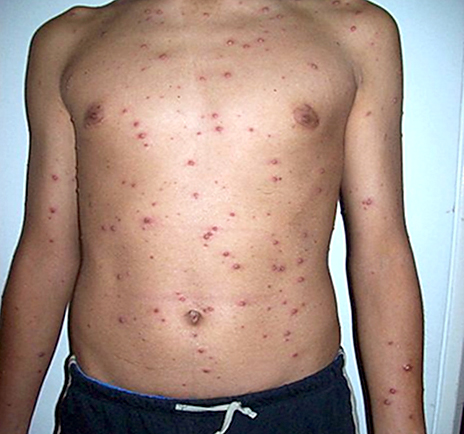 And the problem is that this kid has already been contagious for 2 days even before the rash appeared and will be off limits from school or human contact until the very last pox has scabbed over a couple weeks from now. The only friends he might have until then might be one that has already had it or whose parents have had foresight enough to have them immunized.
And the problem is that this kid has already been contagious for 2 days even before the rash appeared and will be off limits from school or human contact until the very last pox has scabbed over a couple weeks from now. The only friends he might have until then might be one that has already had it or whose parents have had foresight enough to have them immunized.
And the problem with that is that the immunization does a good job BUT is not 100% fool-proof. This is a disease which we need to rely on what we call “herd-immunity,” meaning that enough people have been immunized so that, even if the shot you got isn’t working fully, you still don’t have too great a risk of even being exposed.
The virus is spread by coming in contact with viral particles from skin blisters or by breathing in the viral particles from infected individuals who are coughing or sneezing yards away. Obviously, the best way to prevent chickenpox is vaccination.
High Fever and Body Rash
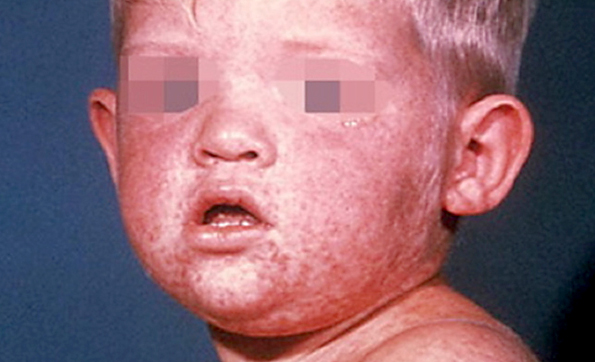 This boy really felt bad and his mom (fortunately) kept him home from school where she watched him develop a fever of 104 degrees, a runny nose and cough then itchy, red eyes. She called his doctor for an appointment and his doctor, knowing that she didn’t believe in immunizations, made the diagnosis pretty much over the phone.
This boy really felt bad and his mom (fortunately) kept him home from school where she watched him develop a fever of 104 degrees, a runny nose and cough then itchy, red eyes. She called his doctor for an appointment and his doctor, knowing that she didn’t believe in immunizations, made the diagnosis pretty much over the phone.
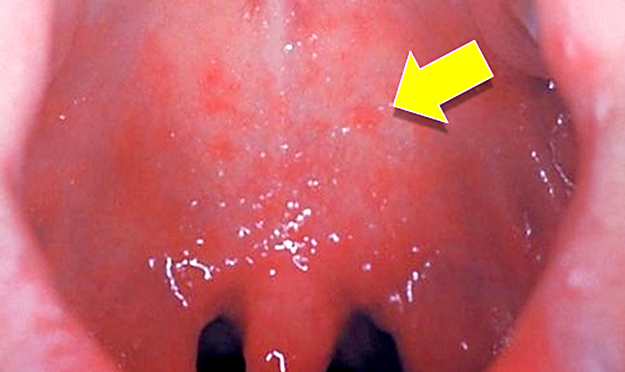 Measles (Rubeola) is one of the most made-of-steel viruses effecting children. It’s a highly contagious respiratory illness because can remain infectious for up to 2 hours out in the air or on surfaces. After your child is exposed it takes one to two weeks to incubate before the high fever starts.
Measles (Rubeola) is one of the most made-of-steel viruses effecting children. It’s a highly contagious respiratory illness because can remain infectious for up to 2 hours out in the air or on surfaces. After your child is exposed it takes one to two weeks to incubate before the high fever starts.
After a few days tiny white “Koplic” spots appear on the soft palate looking like “grains of salt on a wet background.” Wide spread immunization programs have caused a greater than 99% reduction in US cases; BUT, it was one of the “big four” killers of children before immunizations and it STILL is today worldwide!
Whew, that may be enough for one sitting. There are probably some more back to school medical issues that you can think of – they’ll continue in another post, don’t go away.
(Continued in part two)
5 Posts in Back 2 School (back2school) Series
- Refresh: 15 Back to school diseases – 16 Oct 2017
- 5 Back 2 School Issues – 26 Aug 2014
- Back 2 School 2: Mumps - Flu – 4 Oct 2013
- Back 2 School 1: Tinea - Measles – 28 Sep 2013
- Back to School: Intro/Index – 26 Sep 2013
Advertisement by Google
(sorry, only few pages have ads)

